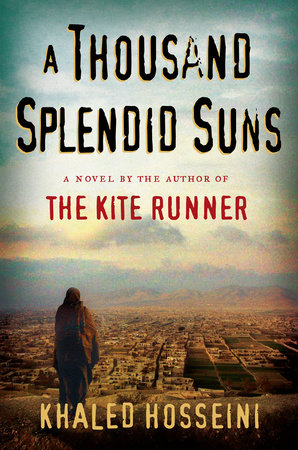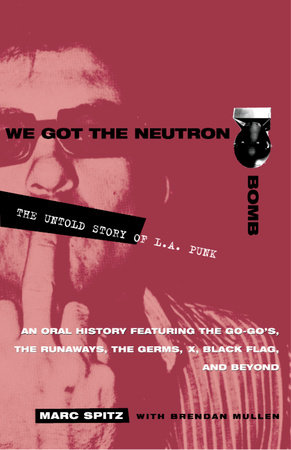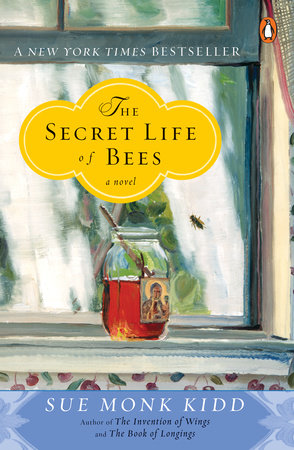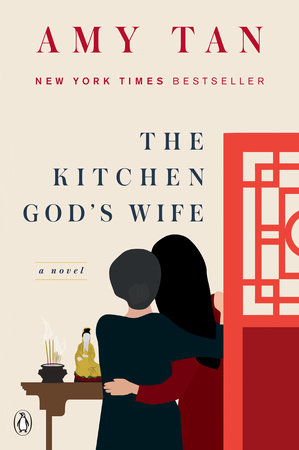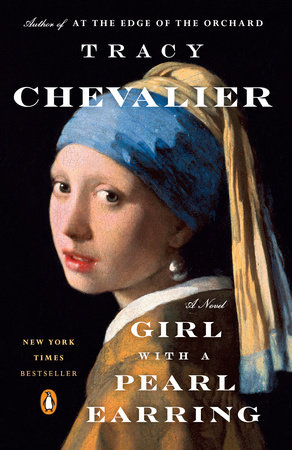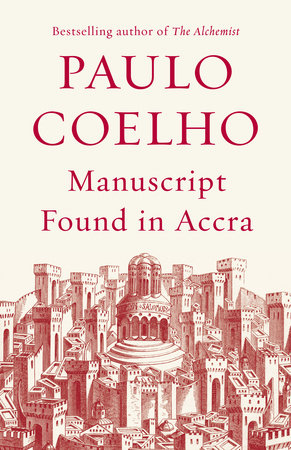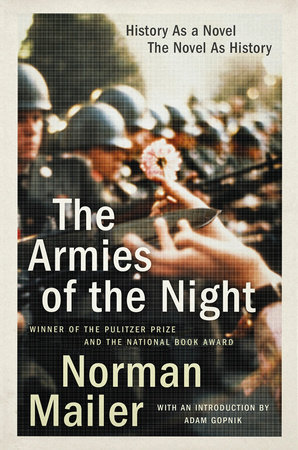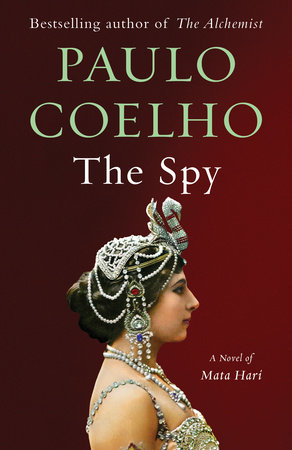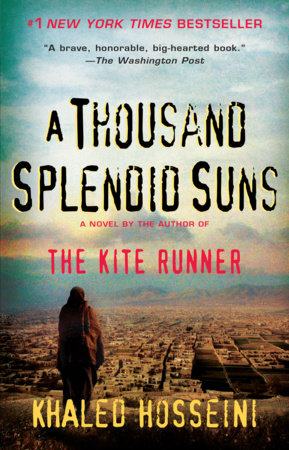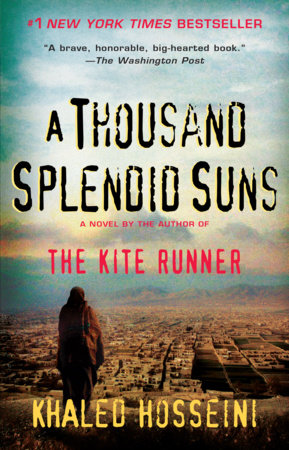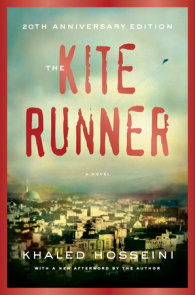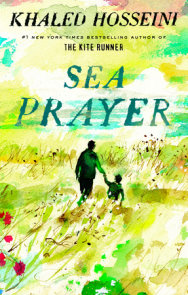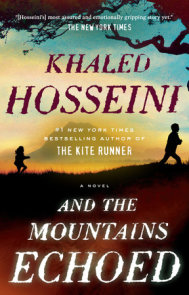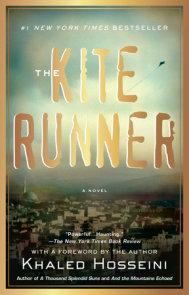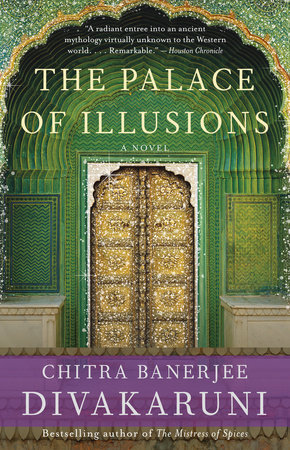Author Q&A
1. The Kite Runner helped alter the world’s perception of Afghanistan, by giving millions of readers their first real sense of what the Afghan people and their daily lives are actually like. Your new novel includes the main events in Afghanistan’s history over the past three decades, from the communist revolution to the Soviet invasion to the U.S.-led war against the Taliban. Do you feel a special responsibility to inform the world about your native country, especially given the current situation there and the prominent platform you’ve gained?
For me as a writer, the story has always taken precedence over everything else. I have never sat down to write with broad, sweeping ideas in mind, and certainly never with a specific agenda. It is quite a burden for a writer to feel a responsibility to represent his or her own culture and to educate others about it. For me it always starts from a very personal, intimate place, about human connections, and then expands from there. What intrigued me about this new book were the hopes and dreams and disillusions of these two women, their inner lives, the specific circumstances that bring them together, their resolve to survive, and the fact that their relationship evolves into something meaningful and powerful, even as the world around them unravels and slips into chaos. But as I wrote, I witnessed the story expanding, becoming more ambitious page after page. I realized that telling the story of these two women without telling, in part, the story of Afghanistan from the 1970s to the post-9/11 era simply was not possible. The intimate and personal was intertwined inextricably with the broad and historical. And so the turmoil in Afghanistan and the country’s tortured recent past slowly became more than mere backdrop. Gradually, Afghanistan itself—and more specifically, Kabul—became a character in this novel, to a much larger extent, I think, than in The Kite Runner. But it was simply for the sake of storytelling, not out of a sense of social responsibility to inform readers about my native country. That said, I will be gratified if they walk away from A Thousand Splendid Suns with a satisfying story and with a little more insight and a more personal sense of what has happened in Afghanistan in the last thirty years.
2. What kind of response do you hope readers have to A Thousand Splendid Suns?
Purely as a writer, I hope that readers discover in this novel the same things that I look for when I read fiction: a story that transports, characters who engage, and a sense of illumination, of having been transformed somehow by the experiences of the characters. I hope that readers respond to the emotions of this story, that despite vast cultural differences, they identify with Mariam and Laila and their dreams and ordinary hopes and day-to-day struggle to survive. As an Afghan, I would like readers to walk away with a sense of empathy for Afghans, and more specifically for Afghan women, on whom the effects of war and extremism have been devastating. I hope this novel brings depth, nuance, and emotional subtext to the familiar image of the burqa-clad woman walking down a dusty street.
3. Where does the title of your new book come from?
It comes from a poem about Kabul by Saib-e-Tabrizi, a seventeenth-century Persian poet, who wrote it after a visit to the city left him deeply impressed. I was searching for English translations of poems about Kabul, for use in a scene where a character bemoans leaving his beloved city, when I found this particular verse. I realized that I had found not only the right line for the scene, but also an evocative title in the phrase “a thousand splendid suns,” which appears in the next-to-last stanza. The poem was translated from Farsi by Dr. Josephine Davis.
4. You recently received the Humanitarian Award from the United Nations Refugee Agency and were named a U.S. goodwill envoy to that agency. What kind of work have you done with the agency? What will your responsibilities be in your position as a goodwill envoy?
It’s been a tremendous honor for me to be asked to work with UNHCR as a goodwill envoy. As a native of a country with one of the world’s largest refugee populations, I hold the issue of refugees close to my heart. I will be asked to make public appearances on behalf of the refugee cause and to serve as a public advocate for refugees around the world. It will be my privilege to try to capture public attention and to use my access to the media to give voice to victims of humanitarian crises and raise public awareness about matters relating to refugees.
In January of this year, I had the opportunity of going to Chad with UNHCR to visit the refugee camps where some 250,000 people from Darfur have sought haven. I had the chance to speak to refugees, local authorities and humanitarian staff and to educate myself about the staggering tragedy unfolding in the region. It was a sobering and heartbreaking experience and one that I will never forget. Presently I am working with UNHCR on the Aid Darfur campaign. It is my intention that my future work with the agency take me to Afghan refugee camps in Pakistan.
5. You present a portrait of Afghanistan under the Taliban that may be surprising to many readers. For example, the Taliban’s ban on music and movies is well known, but many readers are not familiar with the “Titanic fever” that swept through Kabul upon the release of that film, which was shown in secret on black-market VCRs and TVs. How tight a grip did the Taliban truly have on the country? And how does pop culture survive under these traditions?
The Taliban’s acts of cultural vandalism—the most infamous being the destruction of the giant Bamiyan Buddhas—had a devastating effect on Afghan culture and the artistic scene. The Taliban burned countless films, VCRs, music tapes, books, and paintings. They jailed filmmakers, musicians, painters, and sculptors. These restrictions forced some artists to abandon their craft, and many to continue practicing in covert fashion. Some built cellars where they painted or played musical instruments. Others gathered in the guise of a sewing circle to write fiction, as depicted in Christina Lamb’s The Sewing Circles of Heart. And still others found ingenious ways to trick the Taliban—one famous example being a painter who, at the order of the Taliban, painted over the human faces on his oil paintings, except he did with it watercolor, which he washed off after the Taliban were ousted. These were among the desperate ways in which artists tried to escape the Taliban’s firm grip on virtually every form of artistic expression.
6. You earned your medical degree before you began writing fiction. How does being a doctor compare with being a writer?
I enjoyed practicing medicine and was always honored that patients put their trust in me to take care of them and their loved ones. But writing had always been my passion, since childhood, much as with Amir in The Kite Runner. I feel fortunate and privileged that writing is, at least for the time being, my livelihood. It is a dream realized.
I have not found many similarities between my two crafts, except that in both it helps to have at least some insight into human nature. Writers and doctors alike need to understand the motivation behind the things people say and do, and their fears, their hopes and aspirations. In both professions, one needs to appreciate how socioeconomic background, family, culture, language, religion, and other factors shape a person, whether it is a patient in an exam room or a character in a story.
7. In what ways was writing A Thousand Splendid Suns different from writing The Kite Runner?
Well, when I was writing The Kite Runner, no one was waiting for it! The difficulty of writing a second novel is directly proportional to how successful the first novel was, it seems. For me, at the outset, there was a period of self-doubt and hesitation, as well as a recurring tendency to question and reassess my own literary capabilities and limitations. This was especially so when I was aware of the people out there who were eagerly awaiting the book: booksellers, my publisher, and of course, the reading public. This is both wonderful—after all, you want your work to be anticipated—and daunting—your work is anticipated!
Though I did experience some of these apprehensions—as my wife will surely attest—I gradually learned to view them as natural and not unique to me. And as I began to write, as the story picked up pace and I found myself immersed in the world of Mariam and Laila, these apprehensions vanished on their own. The developing story captured me and enabled me to tune out the background noise and get on with the business of inhabiting the world I was creating.
I also think that A Thousand Splendid Suns is, in some ways, a more ambitious book than my first novel. The story is multigenerational, unfolding over almost forty-five years, often skipping ahead years. There is a larger cast of characters, and a dual perspective, and the wars and political turmoil in Afghanistan are chronicled with more detail than in The Kite Runner. This means that I was performing a perpetual balancing act in writing about the intimate—the inner lives of the characters—and depicting the external world that exerts pressure on the characters and forces their fate.
8. Do you see common themes in the two books?
In both novels, characters are caught in a crossfire and overwhelmed by external forces. Their inner lives are influenced by an often brutal and unforgiving outside world, and the decisions they make about their own lives are influenced by things over which they have no control: revolutions, wars, extremism, and oppression. This, I think, is even more the case with A Thousand Splendid Suns. In The Kite Runner, Amir spends many years away from Afghanistan as an immigrant in the United States. The horrors and hardships that he is spared, Mariam and Laila live through; in that sense, their lives are shaped more acutely by the events in Afghanistan than Amir’s life is.
Both novels are multigenerational, and so the relationship between parent and child, with all of its manifest complexities and contradictions, is a prominent theme. I did not intend this, but I am keenly interested, it appears, in the way parents and children love, disappoint, and in the end honor each other. In one way, the two novels are corollaries: The Kite Runner was a father-son story, and A Thousand Splendid Suns can be seen as a mother-daughter story.
Ultimately, I think, both novels are love stories. Characters seek and are saved by love and human connection. In The Kite Runner, it was mainly the love between men. In A Thousand Splendid Suns, love manifests itself in even more various shapes, be it romantic love between a man and a woman, parental love, or love for family, home, country, God. I think in both novels, it is ultimately love that draws characters out of their isolation, that gives them the strength to transcend their own limitations, to expose their vulnerabilities, and to perform devastating acts of self-sacrifice.
9. One of the men in your novel dreams of coming to America, as your family did. He sees America as a kind of golden, generous land. Is that something many Afghans dream still of?
The way Afghans view America and Americans is complex, I think. On the one hand, America is seen as a bastion of hope for Afghanistan. The notion of the American troops packing up and leaving strikes fear into the hearts of many Afghans, I believe, as they dread the chaos, anarchy, and extremism that would likely follow. On the other hand, there is also some sense of disappointment and disillusionment. There is lingering bitterness, I think, about the way Afghans feel they were abandoned by the West—and America in particular—when the Soviets left, a period that was marked by the factional fighting that destroyed so much of Kabul. In addition, there is a growing sentiment, rightfully or not, that promises made by America are not being kept. The average Afghan, I think, had hopes of drastic changes in quality of life, in security conditions, and economic options, when the Americans came to Afghanistan after 9/11. Many Afghans feel that these hopes have not been realized. They feel that the war in Iraq, undertaken so soon after the campaign in Afghanistan, channeled attention, troops, and resources away from Afghanistan. Still, I think most Afghans remain hopeful about their country’s partnership with the U.S. and many echo the sentiment of Babi in A Thousand Splendid Suns, viewing the United States as a desirable place to live, and as a land of opportunity and hope.
10. The women in your story suffer deeply and personally from being oppressed because of their gender, in their homes and in the broader society. Is this oppression particularly onerous in the Muslim world? What can and should be done about it?
This is a complex question with no easy answer. It is undeniable that the treatment of women in some Muslim countries—including my own—has been dismal. The evidence is simply overwhelming. In Afghanistan under the Taliban, women were denied education, the right to work, the right to move freely, access to adequate healthcare, etc. Yet I want to distance myself from the notion, popular in some circles, that the West can and should exert pressure on these countries to grant women equal rights. Though I think this is a well-intended and even noble idea, I see it as too simplistic and impractical. This approach either directly or indirectly dismisses the complexities and nuances of the target society as dictated by its culture, traditions, customs, political system, social structure, and overriding faith.
I believe change needs to come from within, that is, from a Muslim society’s own fabric. In Afghanistan, I think it is essential for its future that those more moderate elements who support women’s rights be empowered. Barring that, the prospects for success are grim. I am always revolted when Islamic leaders, from Afghanistan or elsewhere, deny the very existence of female oppression, avoid the issue by pointing to examples of what they view as Western mistreatment of women, or even worse, justify the oppression of women on the basis of notions derived from Sharia law. I hope that twenty-first-century Islamic leaders can unshackle themselves from antiquated ideas about gender roles and open themselves to a more moderate and progressive approach. I realize that this may sound naive, especially in a country such as Afghanistan, where staunch Islamists still hold sway and look to silence moderate voices. Nevertheless, I think it is the only way that true change can come about, from within Islamic societies themselves.
11. Are you optimistic about the current situation in Afghanistan?
I am an optimistic person by nature, so yes, I do remain cautiously optimistic about Afghanistan’s future. But it must be said that it has been a difficult year for Afghanistan. Aside from the challenges of poverty, poor medical care, lack of education and infrastructure, and the flourishing opium industry, we now have a formidable resurgence by the Taliban and their Al-Qaeda cohorts in the southern and eastern parts of the country. They have given NATO and American troops all that they can handle. The ongoing fighting and the lack of security are chief concerns among Afghans, and have an erosive effect on the image of the Afghan government. There is the risk of disillusion with the Afghan government and with the country’s nascent, fragile democracy, and this makes people susceptible to the influence of the extremists.
12. What is likely to happen in Afghanistan if the current government fails?
I want to state first that I have no expertise in these matters and that any opinion I offer is that of an ordinary thinking citizen who follows the news. That said, I think failure in Afghanistan would be catastrophic not only for Afghanistan but for the West as well. It would fracture the country, and seriously damage the credibility of the west. It would embolden the Taliban, and just as important, those who support the Taliban, namely Al-Qaeda and other extremist Islamic militants. Most ominous of all, it would turn Afghanistan into a safe haven once more for anti-Western jihadis who can gather there and plan their military operations against the United States and its allies.
13. What should the United States and its allies be doing in Afghanistan now?
I will re-iterate my lack of true qualification to answer this. But it seems to me that U.S. and NATO withdrawal from Afghanistan would have disastrous results. At this point, it seems to me the west has no viable choice but to stay committed to the mission in Afghanistan. Simultaneously, the west has to try to empower the central government and help it gain credibility among Afghans, while doing what can be done to eradicate the opium trade and strengthen the country’s economy in an effort to demonstrate to ordinary Afghans the West’s goodwill and its long-term commitment to their country. Military effort alone will not bring success in Afghanistan. This is as much a battle for the trust of the people as it is one against the Taliban.
14. The Kite Runner was centered on the friendship between two men, and the story was told from a male point of view. In your new book, you’ve focused on the relationship between two women, and the tale is told from their alternating perspectives. Why did you decide to write from a female point of view this time? What was it about these particular women and their relationship that gripped you?
I had been entertaining the idea of writing a story of Afghan women for some time after I’d finished writing The Kite Runner. That first novel was a male-dominated story. All the major characters, except perhaps for Amir’s wife Soraya, were men. There was a whole facet of Afghan society which I hadn’t touched on in The Kite Runner, an entire landscape that I felt was fertile with story ideas. After all, so much had happened to Afghan women in the last thirty years, particularly after the Soviets withdrew and factional fighting broke out. With the outbreak of civil war, women in Afghanistan were subjected to gender based human rights abuses, such as rape and forced marriage. They were used as spoils of war. They were abducted and sold into prostitution. When the Taliban came, they imposed inhumane restrictions on women, limiting their freedom of movement, expression, barring them from work and education, harassing them, humiliating them, beating them.
In the spring of 2003, I went to Kabul, and I recall seeing these burqa-clad women sitting at street corners, with four, five, six children, begging for change. I remember watching them walking in pairs up the street, trailed by their children in ragged clothes, and wondering how life had brought them to that point. What were their dreams, hopes, longings? Had they been in love? Who were their husbands? What had they lost, whom had they lost, in the wars that plagued Afghanistan for two decades?
I spoke to many of those women in Kabul. Their life stories were truly heartbreaking. For instance, one woman, a mother of six, told me that her husband, a traffic policeman, made $40 a month and hadn’t been paid in six months. She had borrowed from friends and relatives to survive, but since she could not pay them back, they had stopped lending her money. And so, every day she dispatched her children to different parts of Kabul to beg at street corners. I spoke to another woman who told me that a widowed neighbor of hers, faced with the prospect of starvation, had laced bread crumbs with rat poison and fed it to her kids, then had eaten it herself. I met a little girl whose father had been paralyzed from the waist down by shrapnel. She and her mother begged on the streets of Kabul from sunrise to sundown.
When I began writing A Thousand Splendid Suns, I found myself thinking about those resilient women over and over. Though no one woman that I met in Kabul inspired either Laila or Mariam, their voices, faces, and their incredible stories of survival were always with me, and a good part of my inspiration for this novel came from their collective spirit.
15. This novel has a few strong female characters. How did you create them? Are they based on women you know among your own family and friends, on your reading, on your imagination?
They are not drawn from family members or from people I know. In this respect, this second novel is far less autobiographical than The Kite Runner. Largely they are drawn from my imagination and, even more so, from the women I saw and met in Kabul back in 2003.
16. The Kite Runner was adopted by many reading groups, and by cities and communities as part of their public reading programs. Why do you think that happened? What do you think people take away from your stories?
The Kite Runner is multi-layered, in that it provides readers with cultural, religious, political, historical, and literary points to discuss. But I suspect that also part of the reason it is popular with book groups is that it is a very human story. Because the themes of friendship, betrayal, guilt, redemption, and the uneasy love between fathers and sons are universal and not specifically Afghan, the book has reached across cultural, racial, religious, and gender gaps to resonate with readers of various backgrounds. I think people respond to the emotions in this book.
There is also, of course, international interest in Afghanistan, given the events of 9/11 and the war on terror. For many readers, this book is really the first window into that culture. So there is also a curiosity about that country, which this book addresses to some extent.
17. A movie based on The Kite Runner is now being shot in China. When is it scheduled to be completed? What can you tell us about the movie and the experience of watching your first novel be transformed for the screen?
The shooting wrapped in December 2006. From what I understand, it will be released in the fall of this year, possibly in November.
Being on the set was a surreal experience. Writing a novel is an intensely personal and solitary undertaking. Filmmaking is first and foremost a collaborative process. So it was strange to see dozens of people running around, trying to transforming this very internal creation of mine into a visual experience for everybody else. It was a unique experience to witness the visual interpretation of my thoughts.
In addition, I learned to divorce myself from the notion that everything that I had put on the page would end up on the screen. Inevitably there is going to be a divide between book and film. But to me, the idea is not how closely the adaptation will measure up to my internal images, but rather how the filmmaker will combine the written prose with the power of animated picture to make a visual narrative that can stand on its merits as a work of art, an entity that is separate from its literary precursor, that can be admired for its own virtues and artistry, while remaining faithful to the core emotional experiences that made the book appealing in the first place.
18. How has life changed for you since the publication of The Kite Runner?
I travel a great deal more than I did before. I have seen places that I might not have otherwise—something that kept recurring to me when I was on the movie set in Kashgar, in remote western China. I have a slew of new friends in the literary and publishing community and have had the honor of meeting and speaking with writers whose work I had admired for a long time. Also, I have been on an extended sabbatical from medicine, and have spent the last two years focusing on my writing, something that had long been a dream of mine. My days are shaped now around the creation of stories. As I mentioned before, I am working with UNHCR to raise awareness about refugee issues. So the publication of The Kite Runner has had a profound effect on my life and has changed it dramatically. But as far as my wife, my children, my extended family, and all of my old friends are concerned, nothing at all has changed.
19. You have visited Afghanistan since you came to the United States with your family in 1980. What was it like to go back? Would you like to return again? Is it possible for you to return now?
There is a line in the book where Amir says to his guide, “I feel like a tourist in my own country.” To a large extent I did as well, when I returned to Kabul. After all, I had been gone for more than a quarter of a century. I was not there for the war against the Soviets, for the mujahedeen infighting, or the Taliban. I did not lose any limbs to landmines and did not have to live in a refugee camp. There was certainly an element of survivor’s guilt in my return. I felt, on the one hand, that I belonged there, where everyone spoke my language and shared my culture. On the other hand, I felt like an outsider, a very fortunate outsider, but an outsider nevertheless.
I found that much of the city was either neglected or basically destroyed. There was a shocking number of widows, orphans, people who had lost limbs to landmines and bombs. There was also an abundance of guns and I detected a gun culture in Kabul, something which I did not recall at all of course from the 1970’s.
But the most striking thing to me was that despite the atrocities, the unspeakable brutalities, and the hardships Afghans had endured, they had not lost their humility, their grace, their hospitality, or their sense of hope. I came away very much humbled by their resilience. I certainly do hope to return there again but have no concrete plans at the moment.
